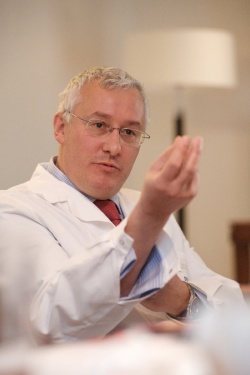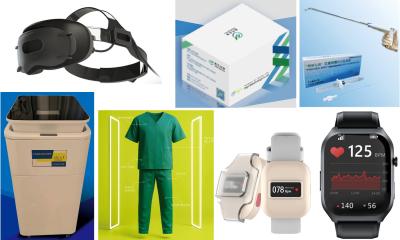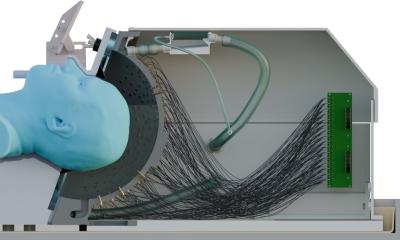Peripheral nerve surgery
Report: Michael Krassnitzer
Neurosurgery has seen enormous progress, which should benefit as many patients as possible. However, according to Prof. Hanno Millesi MD, director of the Millesi Centre for Surgery of Peripheral Nerves, Wiener PrivatKlinik (WPK), a private hospital in Vienna, Austria, ‘methods are perceived incorrectly, because they are often confused with problematic predecessors, and sensible methods are applied incorrectly -- or not used at all. All of this is to the patients’ disadvantage’.

In the run-up to the Third Vienna Symposium on Surgery of Peripheral Nerves (19 –21 March 2010) Prof. Millesi demanded scientifically verified, international standards for peripheral nerve surgery to be mandatory for physicians and health insurers. If, for example, in an accident a few decades ago a motorcyclist tore the plexus brachialis, the nerve bundle responsible for arm movement, from the spinal cord, the arm was usually amputated for want of an alternative. ‘Today,’ said Prof. Millesi, ‘we could restore that arm and function with neurosurgery; afterwards the patient won’t play the piano but he will be able to open doors and he will suffer less pain.’
Medically and ethically problematic is the fact that, in many such cases, public hospitals do not apply current surgical treatment standards that aim to attain functionally useful movement. In general, specialised experts are not consulted. A current study from Austria shows that hardly any operations are performed to improve functions. Prof. Millesi emphasises that the situation is not much different internationally. ‘It must not be a matter of coincidence whether a patient is seen by a physician who knows about the modern treatment options and whether the health insurer is willing to assume the costs for a sensible and modern treatment,’ he said.
At the symposium three spectacular innovations, developed in Austria, were presented. The first accelerates nerve regeneration using impulse waves. Torn nerve connections only grow back at a rate of one millimetre a day. It has now been found that impulse waves can accelerate this process significantly -- almost treble in animal experiments. Low energy impulse waves – i.e. extremely short acoustic impulses, comparable to those used to crush kidney stones -- have been used, each for a millionth of a second. ‘The tissue is only shaken for a moment, assisting the healing effect,’ explained Dr Robert Schmidhammer, partner in the Millesi Centre for Surgery of Peripheral Nerves at WPK and head of the department for neuro-regeneration of the Ludwig Boltzmann Institute for Traumatology.
The second innovation restores the biceps function for patients whose plexus brachialis has been entirely or largely torn from the spinal cord, without having to sacrifice other important nerve functions. Previously, in such cases, one of the two important diaphragm nerves needed for respiration was diverted to the upper arm. However, this meant that many patients had problems because their respiratory muscles then only functioned on one side. ‘Instead, we apply the end-to-side method, the best option in this case. The fibres of the diaphragm nerve are not diverted but tapped on the side,’ Dr Schmidhammer explained. Thus free nerve transplants are placed to connect to the nerve for the biceps. As soon as the nerve fibres arrive there, in the course of their regeneration the nerve that controls respiration also bends the elbow. After a brief period in which the arm is moved by every intensive breath, the brain learns to distinguish these movements.
The third innovation serves to prevent and relieve chronic neuropathic pain. According to the principle use it or lose it brain regions not used for their original tasks are either used for other functions or shut down. In the case of a nerve injury it can take months until the nerve connection to the target organ is restored. During this period, without stimulation the brain forgets the ability to recognise and interpret stimuli from the affected region. Instead intense chronic neuropathic pain can occur. ‘We have found a way at least to retard this process,’ Dr Schmidhammer announced.
Patients are asked to touch a sensor with their numb hand repeatedly and to follow this movement with their eyes. The highly specialised sensor transmits an optical signal and tone, both of which are recognised by the brain. This optical and acoustic information stimulates the tactile centre, which, without such stimulation would rapidly forget its ability. ‘This procedure substantially shortens the rehabilitation phase with respect to higher sensitivity,’ he concluded.
Surgical treatment of nerve damage is important because the injured nerves can lead to intensive chronic neuropathic pain syndromes. Prevention consists of timely restoration of interrupted nerve connections, respectively elimination of the cause of pain at the nerve itself. ‘Unfortunately, such sensible operations are often avoided, although the operation costs are far outweighed by the savings in analgesics,’ Hanno Millesi reflected.
21.05.2010











